Trend and Spatial Distribution of Drug-Resistant Tuberculosis in Liberty-Deprived Populations in the State of Paraná, Brazil
Abstract
1. Introduction
2. Materials and Methods
2.1. Study Scenario
2.2. Population, Source of Information, and Selection Criteria
2.3. Data Analysis
2.4. Ethical Aspects
3. Results
4. Discussion
5. Conclusions
Author Contributions
Funding
Institutional Review Board Statement
Informed Consent Statement
Data Availability Statement
Acknowledgments
Conflicts of Interest
References
- World Health Organization. Global Tuberculosis Report 2020: Executive Summary. 2020. Available online: https://apps.who.int/iris/bitstream/handle/10665/336069/9789240013131-eng.pdf (accessed on 10 September 2021).
- Brazil Ministry of Health. Tuberculosis Epidemiological Bulletin/Ministry of Health. Available online: https://www.gov.br/aids/pt-br/centrais-de-conteudo/publicacoes/2022/boletim-epidemiologico-de-tuberculose-2013-2022/view (accessed on 10 September 2021).
- Brazil Ministry of Health. Manual of Recommendations for Tuberculosis Control in Brazil/Ministry of Health. Available online: https://bvsms.saude.gov.br/bvs/publicacoes/manual_recomendacoes_controle_tuberculose_brasil_2_ed.pdf (accessed on 20 September 2021).
- Ou, Z.; Yu, D.; Liang, Y.; He, W.; Li, Y.; Meng, Y.; Xiong, H.; Zhang, M.; He, H.; Gao, Y.; et al. Trends in burden of multidrug-resistant tuberculosis in countries, regions, and worldwide from 1990 to 2017: Results from the Global Burden of Disease study. Infect. Dis. Poverty 2021, 10, 24. [Google Scholar] [CrossRef] [PubMed]
- Kamolwat, P.; Nateniyom, S.; Chaiprasert, A.; Disratthakit, A.; Mahasirimongkol, S.; Yamada, N.; Smithtikarn, S. Prevalence and associated risk factors of drug-resistant tuberculosis in Thailand: Results from the fifth national anti-tuberculosis drug resistance survey. Trop. Med. Int. Health 2021, 26, 45–53. [Google Scholar] [CrossRef] [PubMed]
- Khan, K.; Riet, G.; Glanville, J.; Sowden, A.; Kleijnen, J. Undertaking Systematic Reviews of Research on Effectiveness: CRD’s Guidance for Those Carrying Out or Commissioning Reviews. NHS Center for Reviews and Dissemination, University of York: York, UK, 2001. [Google Scholar]
- Droznin, M.; Johnson, A.; Johnson, A.M. Multidrug resistant tuberculosis in prisons located in former Soviet countries: A systematic review. PLoS ONE 2017, 12, e0174373. [Google Scholar] [CrossRef] [PubMed][Green Version]
- Brazil. Ministry of Health. Health Surveillance Secretariat. Special Epidemiological Bulletin. v. 1; March 2020. Available online: https://www.gov.br/aids/pt-br/centrais-de-conteudo/boletins-epidemiologicos/2020/tuberculose/25-03_boletim_tuberculose_2020_2.pdf/view#:~:text=O%20presente%20boletim%20apresenta%20os%20principais%20indicadores%20epidemiol%C3%B3gicos,%28PPL%29%20e%20em%20pessoas%20vivendo%20com%20HIV%20%28PVHIV%29 (accessed on 20 September 2021).
- Biadglegne, F.; Rodloff, A.C.; Sack, U. Review of the prevalence and drug resistance of tuberculosis in prisons: A hidden epidemic. Epidemiol. Infect. 2015, 143, 887–900. [Google Scholar] [CrossRef] [PubMed]
- Zeifert, A.P.B.; Cenci, D.R.; Manchini, A. Social justice and the 2030 agenda: Development policies for building fair and inclusive societies. Soc. Rights Public Policy Mag. 2020, 8, 30–52. [Google Scholar]
- Rothman, K.; Greenland, S.; Lash, T. Modern Epidemiology, 3rd ed.; Artmed Editora: Porto Alegre, Brazil, 2016; p. 887. [Google Scholar]
- Brazilian Institute of Geography and Statistics (IBGE). Panorama Paraná. Rio de Janeiro; 2011. Available online: https://cidades.ibge.gov.br/brasil/pr/panorama (accessed on 5 February 2021).
- Brasil. Ministério da Saúde. Secretaria de Ciência, Tecnologia e Insumos Estratégicos. Portaria n°48 de 10 de Setembro de 2013. Available online: https://bvsms.saude.gov.br/bvs/saudelegis/sctie/2013/prt0048_10_09_2013.html (accessed on 15 September 2021).
- Dependent Penitentiary Department. Justice Ministry. Inmates in Prisons in Brazil. 2019. Available online: https://app.powerbi.com/view?r=eyJrIjoiZWI2MmJmMzYtODA2MC00YmZiLWI4M2ItNDU2ZmIyZjFjZGQ0IiwidCI6ImViMDkwNDIwLTQ0NGMtNDNmNy05MWYyLTRIOGRhNmJmZThlMSJ9 (accessed on 5 February 2021).
- Brazil. Law No. 6259, of 30 October 1975: Provides for the organization of Epidemiological Surveillance actions, on the National Immunization Program, establishes rules regarding the compulsory notification of diseases, and other measures. Off. J. Union 1975, 209. [Google Scholar]
- Gordis, L. Epidemiology, 5th ed.; Revinter: Rio de Janeiro, Brazil, 2017; p. 372. [Google Scholar]
- Antunes, J.L.F.; Cardoso, M.R.A. Use of time series analysis in epidemiological studies. Epidemiol. Health Serv. 2015, 24, 565–576. [Google Scholar] [CrossRef]
- Box, G.E.P.; Jenkins, G.M. Time Series Analysis: Forecasting and Control, 5th ed.; Wiley: Hoboken, NJ, USA, 1976; 712p. [Google Scholar]
- Camel, H.N.; Lucio, O.S.; Leal, J.B.V.; Carvalho, P.C.M. Time Series Forecasting Methods and Hybrid Modeling both Applied to Monthly Wind Speed Averages for Northeast Regions of Brazil. Braz. J. Meteorol. 2017, 32, 565–574. [Google Scholar] [CrossRef][Green Version]
- Da Costa, J.M.; De Oliveira, R.S. General data protection law Applied to healthcare. Humanit. Innov. 2021, 8, 136–143. [Google Scholar]
- Getis, A.; Ord, J.K. The analysis of spatial association by use of distance statistics. Geogr. Anal. 1992, 24, 189–206. [Google Scholar] [CrossRef]
- Kulldorff, M.; Nagarwalla, N. Spatial disease clusters: Detection and inference. Stat. Med. 1995, 14, 799–810. [Google Scholar] [CrossRef] [PubMed]
- Kayomo, M.K.; Hasker, E.; Aloni, M.; Nkuku, L.; Kazadi, M.; Kabengele, T.; Muteteke, D.; Kapita, F.; Lufulwabo, A.; Mukadi, Y.D.; et al. Tuberculosis and Multidrug-resistant Tuberculosis Outbreak, Mbuji-Mayi Central Prison, Democratic Republic of Congo. Emerg. Infect. Dis. 2018, 24, 2029–2035. [Google Scholar] [CrossRef] [PubMed]
- Warren, J.L.; Grandjean, L.; Moore, D.A.J.; Lithgow, A.; Coronel, J.; Sheen, P.; Zelner, J.L.; Andrews, J.R.; Cohen, T. Investigating the spillover of multidrug-resistant tuberculosis from a prison: A spatial and molecular epidemiological analysis. BMC Med. 2018, 16, 122. [Google Scholar] [CrossRef] [PubMed]
- Jugheli, L.; Rigouts, L.; Shamputa, I.C.; Bram de Rijk, W.; Portaels, F. High levels of resistance to second-line anti-tuberculosis drugs among prisoners with pulmonary tuberculosis in Georgia. Int. J. Tuberc. Lung Dis. 2008, 12, 561–566. [Google Scholar] [PubMed]
- Winetsky, D.E.; Almukhamedov, O.; Pulatov, D.; Vezhnina, N.; Dooronbekova, A.; Zhussupov, B. Prevalence, risk factors and social context of active pulmonary tuberculosis among prisoners in Tajikistan. PLoS ONE 2014, 9, e86046. [Google Scholar] [CrossRef] [PubMed]
- Bhatnagar, T.; Ralte, M.; Ralte, L.; Chawnglungmuana; Sundaramoorthy, L.; Chhakchhuak, L. Intensified tuberculosis and HIV surveillance in a prison in Northeast India: Implementation research. PLoS ONE 2019, 14, e0219988. [Google Scholar] [CrossRef] [PubMed]
- Allgayer, M.F.; Ely, K.Z.; Freitas, G.H.; Valim, A.R.M.; Gonzales, R.I.C.; Krug, S.B.F.; Possuelo, L.G. Tuberculosis: Health care and surveillance in prisons. Rev. Bras. Enferm. 2019, 72, 1304–1310. [Google Scholar] [CrossRef] [PubMed]
- Moreira, J.A.; Alves, M.R. Deprivation of liberty or rights: An integrative review of tuberculosis in the Brazilian prison system. Aceno—Rev. Antropol. Centro-Oeste 2021, 8, 231–244. [Google Scholar]
- Brazil Interministerial Ordinance, No. “1, of January 2, 2014. Establishes the National Policy for Comprehensive Health Care for Persons Deprived of Liberty in the Prison System (PNAISP) within the Scope of the Unified Health System (SUS)”. Official Journal of the Union 2; 2014. Available online: https://bvsms.saude.gov.br/bvs/saudelegis/gm/2014/pri0001_02_01_2014.html (accessed on 10 February 2022).
- Rocha, M.S.; Bartholomay, P.; Cavalcante, M.V.; Medeiros, F.C.; Codenotti, S.B.; Pelissari, D.M.; Andrade, B.A.; Silva, G.D.M.; Arakaki-Sanchez, D.; Pinheiro, R.S. Sistema de Informação de Agravos de Notificação (Sinan): Principais características da notificação e da análise de dados relacionada à tuberculose. Epidemiol. Serv. 2020, 29, e2019017. [Google Scholar] [CrossRef] [PubMed]
- Gurbanova, E.; Mehdiyev, R.; Blondal, K.; Altraja, A. Predictors of cure in rifampicin-resistant tuberculosis in prison settings with low loss to follow-up. Int. J. Tuberc. Lung Dis. 2016, 20, 645–651. [Google Scholar] [CrossRef] [PubMed]
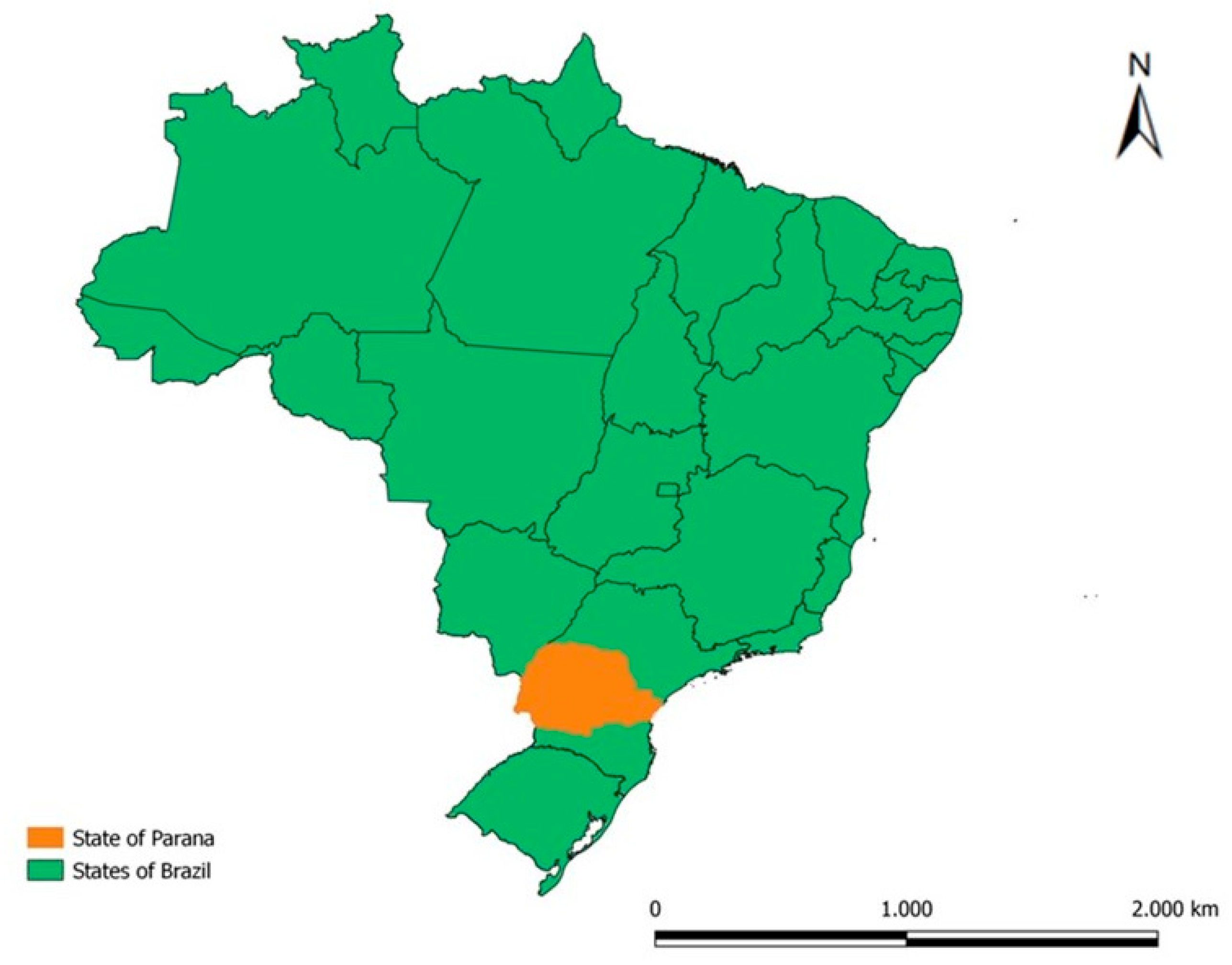
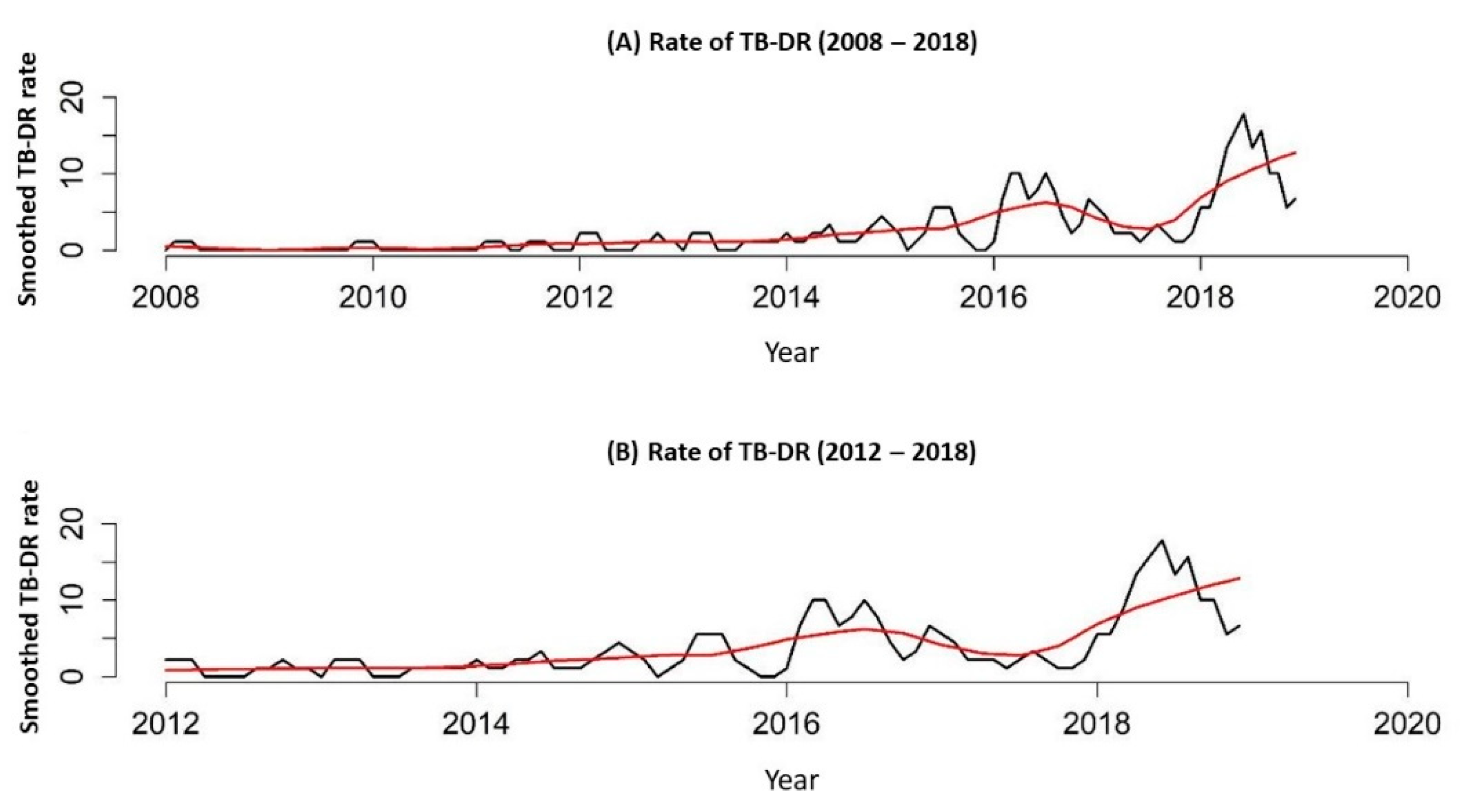
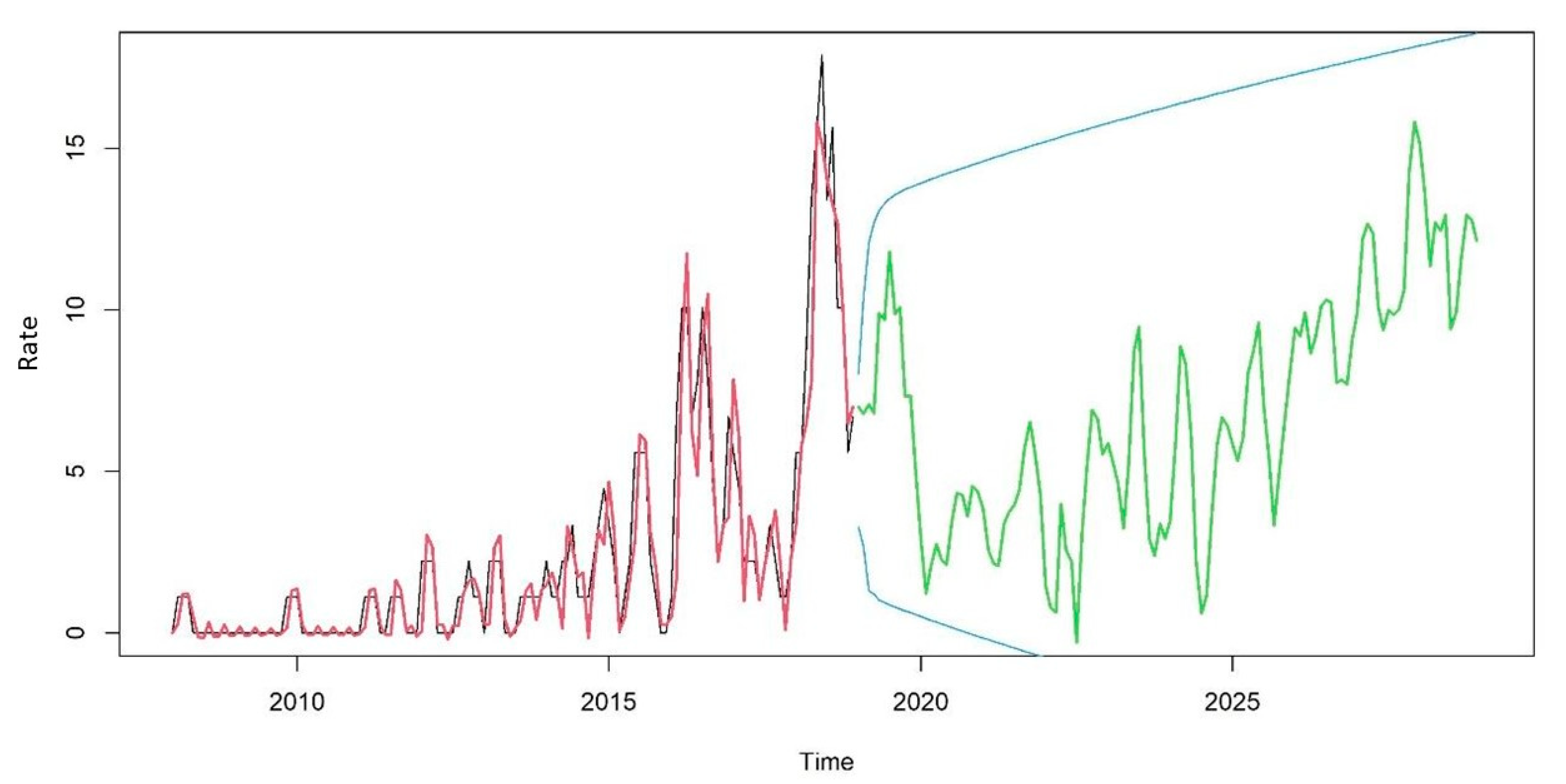
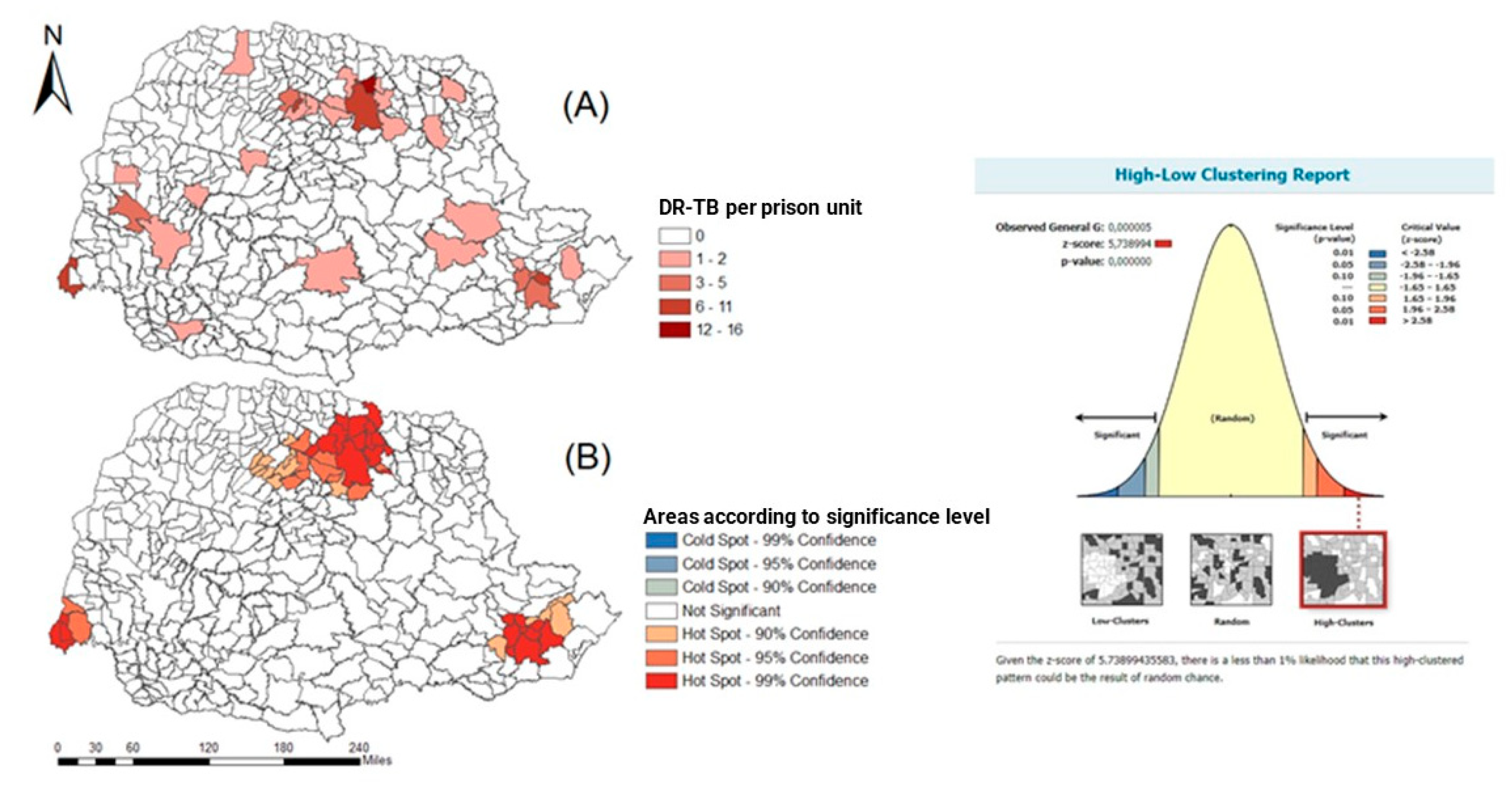
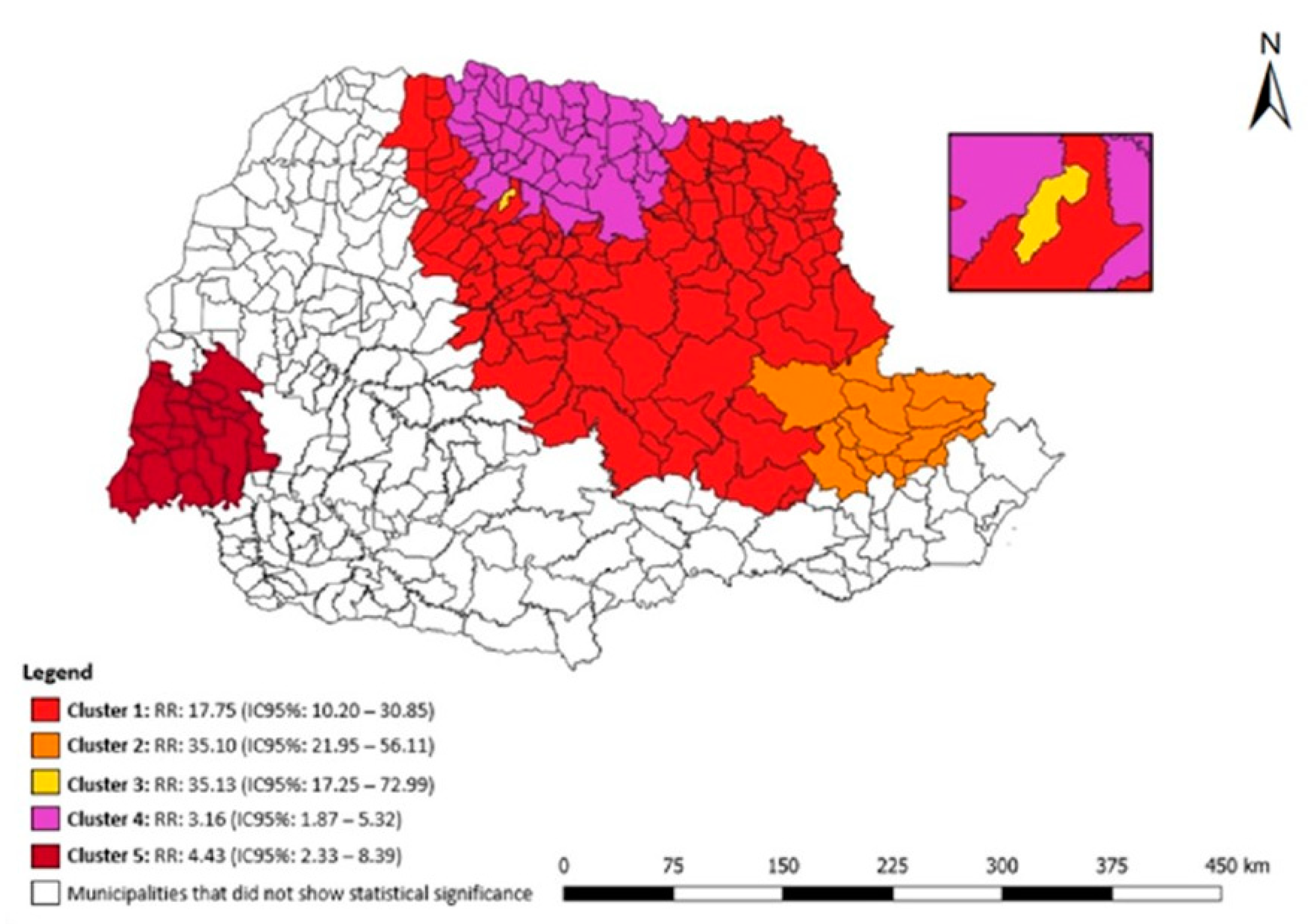
Publisher’s Note: MDPI stays neutral with regard to jurisdictional claims in published maps and institutional affiliations. |
© 2022 by the authors. Licensee MDPI, Basel, Switzerland. This article is an open access article distributed under the terms and conditions of the Creative Commons Attribution (CC BY) license (https://creativecommons.org/licenses/by/4.0/).
Share and Cite
Santos, M.S.d.; Berra, T.Z.; Scholze, A.R.; Delpino, F.M.; Ramos, A.C.V.; Alves, Y.M.; Costa, F.B.P.d.; Almeida Crispim, J.d.; Giacomet, C.L.; Moura, H.S.D.; et al. Trend and Spatial Distribution of Drug-Resistant Tuberculosis in Liberty-Deprived Populations in the State of Paraná, Brazil. Trop. Med. Infect. Dis. 2022, 7, 266. https://doi.org/10.3390/tropicalmed7100266
Santos MSd, Berra TZ, Scholze AR, Delpino FM, Ramos ACV, Alves YM, Costa FBPd, Almeida Crispim Jd, Giacomet CL, Moura HSD, et al. Trend and Spatial Distribution of Drug-Resistant Tuberculosis in Liberty-Deprived Populations in the State of Paraná, Brazil. Tropical Medicine and Infectious Disease. 2022; 7(10):266. https://doi.org/10.3390/tropicalmed7100266
Chicago/Turabian StyleSantos, Márcio Souza dos, Thaís Zamboni Berra, Alessandro Rolim Scholze, Felipe Mendes Delpino, Antônio Carlos Vieira Ramos, Yan Mathias Alves, Fernanda Bruzadelli Paulino da Costa, Juliane de Almeida Crispim, Clóvis Luciano Giacomet, Heriederson Sávio Dias Moura, and et al. 2022. "Trend and Spatial Distribution of Drug-Resistant Tuberculosis in Liberty-Deprived Populations in the State of Paraná, Brazil" Tropical Medicine and Infectious Disease 7, no. 10: 266. https://doi.org/10.3390/tropicalmed7100266
APA StyleSantos, M. S. d., Berra, T. Z., Scholze, A. R., Delpino, F. M., Ramos, A. C. V., Alves, Y. M., Costa, F. B. P. d., Almeida Crispim, J. d., Giacomet, C. L., Moura, H. S. D., Teibo, T. K. A., Peres, A. C. S., Freitas, G. L. d., Pieri, F. M., & Arcêncio, R. A. (2022). Trend and Spatial Distribution of Drug-Resistant Tuberculosis in Liberty-Deprived Populations in the State of Paraná, Brazil. Tropical Medicine and Infectious Disease, 7(10), 266. https://doi.org/10.3390/tropicalmed7100266







